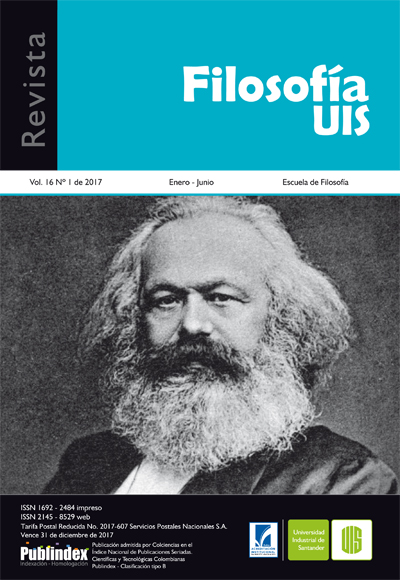Autonomous technology and its possibility in the tragic
Published 2017-09-11
Keywords
- philosophy of technology,
- ways of being of technology,
- lethal autonomous eapons systems,
- ontology technology,
- transhumanism
How to Cite
Copyright (c) 2017 Revista Filosofía UIS

This work is licensed under a Creative Commons Attribution 4.0 International License.
Abstract
This article aims to identify those elements that make up the current technological advances and they overstep the dimensions of technology proposed by analysts as Pacey and Mitcham, therefore, not possible to understand the phenomenon in its absoluteness and its new complexity. To achieve this, it goes to analize the case of Autonomous Lethal Weapon System (LAWS); it consists of three stages, the first is the exposure of the phenomenon LAWS. A second moment, examines the case in light of the dimensions proposed by Mitcham and Pacey. As an exercise of current situation, and future trends, the article is complemented with a reflection on the new horizon that unfolds, thus allowing the construction of a new technological ontology, an ontology that transcends the human, a transhumanist ontology.
Downloads
References
Arkín, R. C. (2007). Governing Lethal Behavior: Embedding Ethics in a Hybrid Deliberative/Reactive Robot Architecture, Report GIT-GVU-07-11.
Gentilli, C., & Garelli, G. (2015). Lo trágico. (E. Jalain, Trad.) Madrid: La balsa de la medusa.
Gomila, A. (2010). “Ética para robots: retos morales al hilo de la nueva generación de agentes autónomos”. En: Autómatas, robots y otras figuras de la construcción femenina. De Galatea a Barbie. Madrid: Lengua de Trapo.
Heidegger, M. (1997). La pregunta por la técnica. En: Filosofía, ciencia y técnica. Santiago de Chile: Editorial Universitaria.
Husserl, E. (2008). La crisis de las ciencias europeas y la fenomenología trascendental. Buenos Aires: Prometeo Libros.
Iribarne, J.V. (2008). Estudio Preliminar. En La crisis de las ciencias europeas y la fenomenología trascendental. Buenos Aires: Prometeo Libros.
Kurzweil, Ray. (2013). Cómo crear una mente. Traductor: Carlos García Hernández. Berlín: Editorial Lola Books.
Méndez, J. A. (2007). “Más allá del Gestell. Tecnología y Voluntad”. Revista de Filosofía Eikasia. 11, p. 1-52.
Mitcham, C. (1989). ¿Qué es la filosofía de la tecnología? (C. Cueto Nieto, & R. Méndez Stingl, Trans.) España: Anthropos.
Mitcham, C. (1994). Thinking through Technology. The path between Engineering and Philosophy. Chicago: The University of Chicago Press.
Ortega y Gasset, J. (1968). La meditación de la técnica. Madrid: Ediciones Revista de Occidente.
Pacey, A. (1990). La cultura de la tecnología. México: Fondo de Cultura Económica.
Sharkey, N. E. (2012). The evitability of autonomous robot warfare. International review of the Red Cross, 787-799.
Singer, P.W. (2009). Robots at War: The New Battlefield. The Wilson Quarterly, 33 (1): 30-48.
Sloterdijk, P. (2011). “La domesticación del Ser. Por una clarificación del claro”, en Sin Salvación tras la huellas de Heidegger. Madrid: Editorial Akal.
Berná- Martínez, J. V., & Maciá Pérez, F. (2011). “Control Robórico inspirado en los principios de la neurociencia”. Recuperado de: http://www.dtic.ua.es
Economía y Negocios. (2015). “Una guerra con robots autónomos ya dejó de ser ciencia ficción”. Recuperado de: http://www.economiaynegocios.cl
Keisner, A. C., Raffo, J., & Wunsch-Vincent, S. (2015). “Economic Research- Breakthrough technologies –Robotics, innovation and intellectual property”.Tomado de: Intellectual Property Organization- WIPO. Recuperado de:
HYPERLINK "http://www.wipo.int/edocs/pubdocs/en/wipo_pub_econstat_wp_30.pdf" www.wipo.int/edocs/pubdocs/en/wipo_pub_econstat_wp_30.pdf
Knight, W. (2015). “¿Pueden los robots militares tomar el control?” Tomado de Technology review. Recuperado de: https://www.technologyreview.es
Moriello, S. (2005). “Los robots autónomos inteligentes son la nueva generación”. Tomado de Observatorio Tecnológico del Metal. Recuperado de: http://observatorio.aimme.es/noticias/ficha.asp?id=1289
Naciones Unidas. (2015). Informe de la reunión oficiosa de expertos de 2015 sobre sistemas de armas autónomas letales LAWS. Tomado de UNOG The United Nations office at Geneva. Recuperado de: http://www.unog.ch/
Naciones Unidas. (2014). “Informe del Relator Especial sobre las ejecuciones extrajudiciales, sumarias o arbitrarias”. Tomado de UNOG The United Nations office at Geneva. Asamblea General 6 de Agosto de 2014. Recuperado de: http://www.acnur.org/t3/fileadmin/Documentos/BDL/2014/9750.pdf?view=1
Naciones Unidas. (2013). “Informe del Relator Especial sobre las ejecuciones extrajudiciales, sumarias o arbitrarias, Christof Heyns.” Ginebra. Tomado de UNOG The United Nations office at Geneva. General Assembly. Recuperado de: http://www.unog.ch/80256EDD006B8954/(httpAssets)/684AB3F3935B5C42C1257CC200429C7C/$file/Report+of+the+Special+Rapporteur+on+extrajudicial,.pdf
Nakhaeinia, D., Tang, S. H., Mohd Noo, B., & Motlagh, O. (2011) “A review of control architectures for autonomous”. Tomado de International Journal of the Physical Sciences. Recuperado de: http://www.academicjournals.org/IJPSQUO- Hearst Magazines. (2015). “La era de los roborts asesinos”. Recuperado de: http://www.quo.es/
The United Nations office at Geneva. (April de 2015). 2015 Meeting of Experts on LAWS. Recuperado el 2016 de Enero de 20, de http://www.unog.ch/80256EE600585943/(httpPages)/6CE049BE22EC75A2C1257C8D00513E26?
OpenDocument
